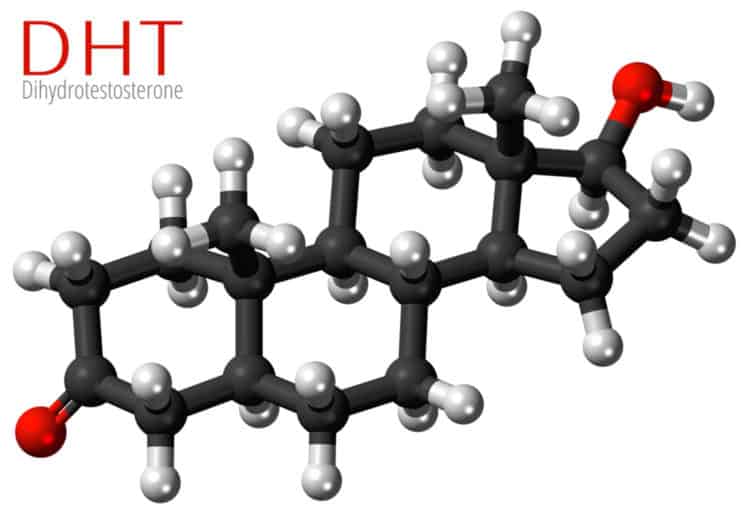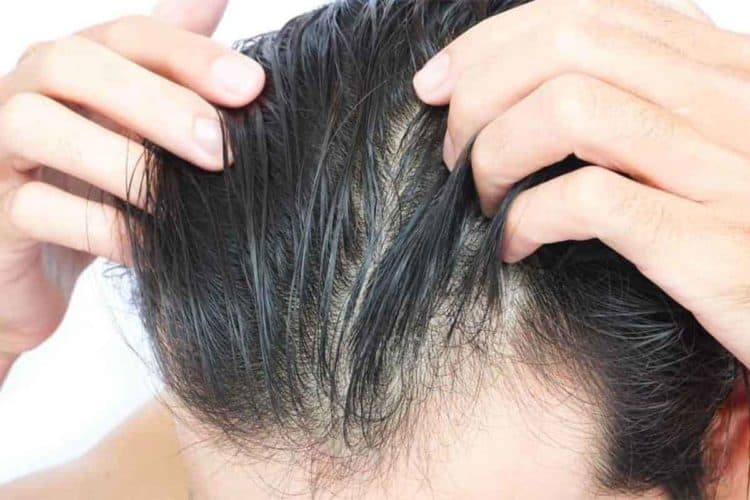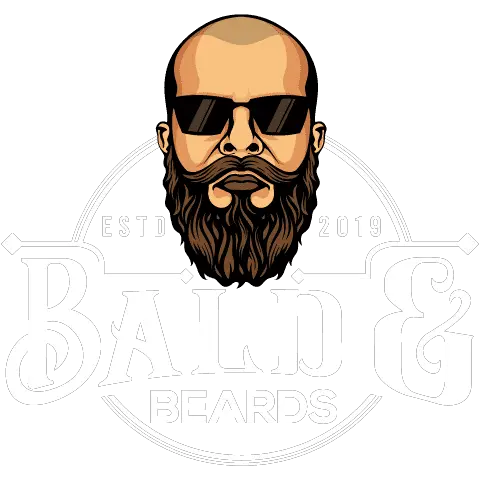With aging comes hair loss, but how much is normal and when is it considered pattern baldness? Either way, it can be very emotional and you should know all the facts first.
Male pattern baldness (AKA androgenic alopecia) is a genetic condition caused by DHT hormone changes, resulting in hair loss. It’s also the most common cause of hair loss for men. Studies have shown it affects over 50% of all men before they turn 50 years old.
If you have a family history of baldness or starting to lose your hair, then keep reading to find everything you need to know about baldness, causes, treatments and remedies.
What Causes Male Pattern Baldness?
The main cause of hair loss in men is due to androgenic alopecia. For genetic reasons, male baldness is hard to prevent naturally.
If you have a family history of baldness in men, then research has found you have the same issue with a sex hormone called androgen or dihydrotestosterone (DHT). Androgenic hormones do many things for your body, including the regulation of hair growth.
DHT is produced naturally by your body, but it’s a byproduct of testosterone. This means that your body converts testosterone into DHT on its own. Why though, right?

During childhood and puberty, DHT is an important hormone that helps you form male features, such as body hair, genitalia, jaw shape, voice, and other male characteristics. As men age, DHT attaches to your hair follicles. Once it does so, the hormone blocks the follicle and slows hair growth, eventually killing the follicle completely.
While DHT is in every man’s body, it doesn’t affect others the same way. In other cases, young men are highly susceptible to DHT, and baldness may start in teens or early 20s. But typically, you won’t notice a receding hairline until your mid-30s.
Hair Growth Cycle
While every hair follicle on your head has its own growth cycle, the same follicle has a much shorter and weaker life span with male pattern hair loss. The hair follicle begins to shrink, producing short, fine strands. The growth cycle eventually comes to an end for these hair strands, and no new hair grows back after the follicle dies.
Hair Loss Triggers
When male pattern hair loss is inherited, baldness may start earlier than expected. Men typically see a mature hairline in their late 20s and early 30s. There are some conditions that exacerbate hair loss, such as cancer, medication, thyroid problems, and steroids. If you notice hair loss rapidly increasing after taking certain medications, then you should check with your doctor about another medication to prevent your hair from thinning.
Most doctors look for a pattern of hair loss to diagnose male pattern hair loss. This information comes from looking over family medical history and an exam to rule out other issues, such as dry scalp or other fungal problems. Certain skin conditions can lead to more hair loss. If you notice a red scalp, bald dandruff, peeling, scales, or other problems, you should see a dermatologist to get help for your skin.
Who’s at Risk for Male Pattern Hair Loss?
Some men start to experience a mature hairline in their teens, which is defined by hair loss in the corners of the scalp. You may notice your hair line starting to recede and patches of thinning hair at the beginning of male pattern hair loss. However, this condition typically starts when transition into their 30s. If you have a relative with baldness, then you may be at a higher risk.
To know if you’re at risk, you can talk to a doctor. Studies also have shown that relatives on the maternal side of the family carry the baldness gene.
Risk Factors for Male Pattern Hair Loss:
- Family history of hair loss is the biggest risk factor for baldness. If your mother or both parents have a history of hair loss, then you’re likely to experience hair loss in your loss.
- Older men typically go bald faster because they have a longer exposure to DHT. Most men in their 40s, 50s, and 60s experience bald patches and receding hairlines.
- There are certain medications that amplify DHT’s effects. This means that your baldness can get worse, especially if you’re taking medications to treat low testosterone levels.
Types of Hair Loss
If you start to notice your forehead seems more prominent and patches of hair are missing, then you may be losing your hair. Some men only have a single patch of hair that thins, while others have a receding hairline that forms a “V” shape. If your hair line continues to recede, then you may lose most of your hair by the time you are 50.
There are some ways to slow hair loss or even stop hair loss with some medications. Others choose hair transplant surgery to replace the follicles with active ones.

Receding Hairline
This is the first symptom that men typically see with hair loss. As you age, you may notice your hairline isn’t as straight across as it used to be. The “V” or “M” shape hairline is also a mature hairline that may not mean you will go completely bald. The receding corners are part of growing up and simply show that your juvenile hairline is growing up.
You can always look to the men on your mother’s side to note whether you’ll have early onset baldness or full baldness. In many cases, your hair may just thin over time in the corners but not lead to more prominent bald patches at the back or crown of your head. You can always find a new hairstyle for your receding hairline that improves your thinning look.
Thinning Crown
Others notice hair thinning on the top or crown of their head. This is more difficult to see in the mirror. You may not notice it until you feel bald patches of hair at the top of your head while showering or combing your hair. You may need to use a handheld mirror to check this spot or take a selfie to see hair loss.
Diffuse Thinning
This is another type of baldness that affects your entire head of hair. You may notice a gradual thinning all over with more shedding. However, it’s not as common as a receding hairline or thinning crown. You can typically see this type of thinning after a shower when your hair is wet.
Symptoms of Balding in Men
Most men experience early signs of balding (gradual thinning) and hair loss as they grow older. You may not notice a thinning hairline for many years until it becomes more prominent.
The change often results in a larger forehead or a high “V” shape, also known as a widow’s peak. You may notice that your hair feels and looks thinner when it’s wet or under harsh lighting.
Hair Loss Treatments
Medical treatment isn’t necessary if there are no other health conditions associated with the hair loss. However, if you want to keep your hair, you may consider some medications on the market that have success at preventing hair loss and even regrowing hair. If you seek the appearance of thick hair and a younger hairline, you may need to look into hair transplant surgery.
These are some methods that have helped treat male pattern baldness:
Medications
From topical ointments to pills, there are a few ways that doctors have come up to help men with baldness. These are the most successful according to patient studies.
Minoxidil AKA Rogaine
Rogaine is a popular topical medication that you can apply to your head to prevent hair loss and even regrow hair. Minoxidil is able to slow down hair loss and re-stimulate hair follicles to grow hair once more. However, Rogaine takes about four months to a full year to show results. Hair loss also occurs if you stop applying the cream.
There are some side effects associated with Rogaine. These include irritation, burning, dry scalp, scaling, and other skin problems. If you notice these issues, you should talk to a doctor immediately. There are some other serious side effects that indicate a deeper medical problem:
- Weight gain
- Swelling of face, ankles, abdomen, and hands
- Trouble breathing when you lay down
- Rapid heartbeat
- Labored respiration
- Tight chest
- Chest pain
Rogaine is only one treatment, but it has been the most effective topical for hair loss.
Finasteride AKA Propecia or Proscar
Finasteride is a pill that has been studied extensively for hair loss. Most participants used finasteride to slow down hair loss. The medication works by blocking the male hormone responsible for hair loss. While Propecia has a higher probability of working, your hair loss returns if you ever stop taking the medication.
Patients also have to take finasteride for 90 days to one year to start seeing results. If you don’t see hair growth after one year, then your doctor will likely take you off of the medication.
There are some side effects for some men who take Propecia. These include:
- Depression
- Itching
- Hives
- Breast tenderness
- Rash
- Face swelling
- Painful ejaculation
- Erectile dysfunction
- Testicular pain
Some studies on finasteride also revealed that patients developed breast cancer. If you have a history of breast cancer in your family, your doctor may deem you at risk and not prescribe Propecia.
In addition, you’ll need to have an exam to get approval for this medication. Doctors check prostate-specific antigens (PSAs) to see if you’re at risk for prostate cancer. The medication lowers PSA levels, which can cause lower than normal scores for the test. If you experience a rise in PSA levels while taking finasteride, then you may need to be checked for prostate cancer.
Hair Transplant Surgery
Another option to regrow your hair is through hair transplantation. This is an invasive treatment that removes hair follicles from other areas and transplants them into your scalp, where you need to regrow hair.
The surgery can be quite expensive if you need to transplant multiple follicles in various places. It’s also necessary that you go to the doctor for multiple treatments, and it can be quite painful for up to three weeks following the procedure.
This hair restoration procedure is a permanent solution for hair loss. You will have a natural, thick hairline that will never fade.
Hairstyles
Most balding men typically shave their heads or may opt for different balding hairstyles, such as a comb over. If you don’t have too much hair loss yet, it’s easier to hide some missing patches. Hair stylists may also help with different products to thicken and style your hair.
If you decide to shave your head, you won’t have to worry about these treatments or side effects. While it’s not always easy to transition, many men look great bald, including Jason Statham, Dwayne “The Rock” Johnson, Vin Diesel, and even Channing Tatum.
Wigs and Hairpieces
You can use hair pieces and wigs to cover up thinning hair and receding hairlines. There are all kinds of styles, colors, textures, and so forth. For a natural look, you can visit a hair stylist to discuss hair pieces and create a natural look.
You may also be interested in modern weaves for men that look and act like your real hair. Weaves stay on even when you shower or swim.
Can You Prevent Hair Loss?
Currently, there isn’t a way to prevent hair loss without medical treatment. There are some theories that note stress as a huge factor for the early development of hair loss and thinning. This is because stress leads to higher cortisone levels and produces sex hormones in the body that contribute to hair loss.
Other options you might try:
- Improving your diet
- Hair loss vitamins & supplements
- Hair loss shampoos
- Laser Therapy for hair loss
- Rogaine (Minoxidil)
If you’ve noticed an increase in hair loss related to stress, the best way is to exercise and meditate. You need to relieve stress through activities in order to prevent it from taking over your body.
Tips from Men with Hair Loss
Even though everyone loses 100 strands per day, there could be other factors affecting hair loss, such as diet, medications, stress, pollution, genetics, and mineral deficiency. In addition, there have been studies that break down whether wearing caps, hats, helmets, and beanies affect male pattern hair loss – read more here.
These tips have helped men reduce or slow down hair loss, but most men will go through some hair thinning by the age of 50.
- Wash your hair with a mild, natural shampoo
- Get treatment for dandruff, dry scalp, or irritation that could lead to more hair loss
- Take vitamins A and E to help with hair regrowth and with baldness
- Eat lean meats, soy, fish, and other protein
- Massage your scalp with essential oils
- Avoid brushing wet hair
- Stay hydrated
- Reduce stress
- Rub green tea into your hair
- Avoid rubbing hair with a towel, just it dry naturally
- Reduce drinking alcohol
- Exercise regularly
- Avoid wearing hats for multiple hours, particularly when outside


